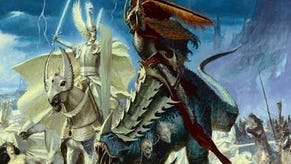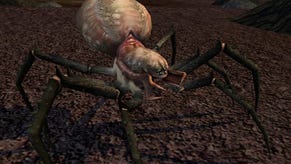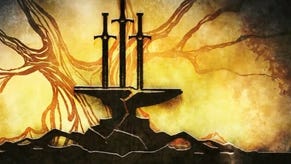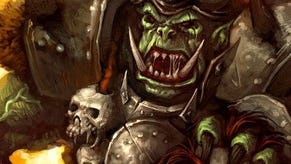Warhammer Online: Age of Reckoning
Please, Warhammer, don't hurt 'em.
Looked at from one angle, Warhammer Online: Age of Reckoning is a game with everything going for it. It has a licence perfectly suited to a massively multiplayer RPG with the kind of classical high fantasy setting that has been the basis of virtually every successful MMO to date, from Ultima to Lord of the Rings. It has an experienced developer in the form of Mythic, creators of Dark Age of Camelot, and the bottomless resources of Mythic's new owners EA (although GOA will publish and operate the game in Europe). It has another few months in development to ensure it's as good as it can be. It has a wide-open path to the mainstream, conveniently bulldozed by genre phenomenon World of Warcraft. It has simple, familiar basics backed up by a truckload of big and rather brilliant ideas.
Look at it another way, and WAR - to use the preferred and pointed acronym - is a game with a mountain to climb. It has a fantasy setting trampled into cliché by over a decade of identikit MMOs. It has a developer encumbered with expectations and preconceptions in a field where no team has ever hit big twice, backed by a publisher so uncertain of MMOs that it has outsourced the European release. It has suffered yet another damaging delay that has angered fans and thrown it into the merciless path of WOW expansion Wrath of the Lich King. It's doomed to live in the shadow of Blizzard's juggernaut, a game with which it shares all too many similarities. Its big ideas aren't immediately apparent because the basics of the game are so conventional.
Both viewpoints are equally valid, and you could go mad trying to reconcile them. Mythic, to its credit, isn't bothering. It's just getting its head down and doing its best to sharpen the one sword it has that isn't double-edged: those big ideas.
Whilst it's not fair to say that Warhammer Online is attempting to revolutionise MMOs, it's more than fair to say that it has a several smart and interesting innovations at its core. These ought to set it apart from the competition and attract any seasoned MMO player. Many - but not all - are based around the "realm versus realm" system championed by Mythic, and adapted from Dark Age. "RVR" pits entire races of players against each other in epic, long-term, large-scale, city-sacking warfare.
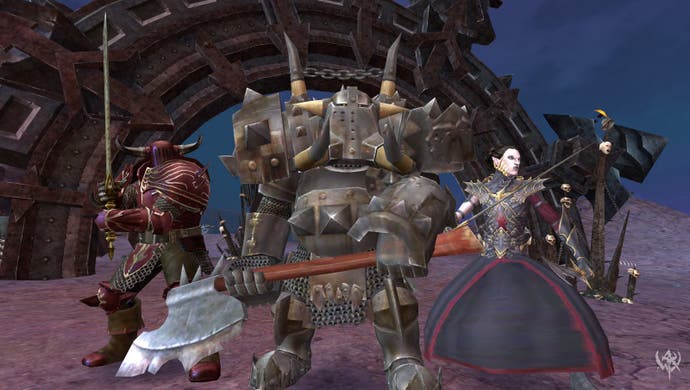
The key thing to understand about realm warfare is that everything you do in the game - whether fighting other players or not - contributes to it. The game's six races are grouped into pairs of antagonists: dwarves and "greenskins" (orcs and goblins), high elves and dark elves, the humans of the Empire and the corrupted humans of Chaos. The realms of each pair are arranged in a parallel, linear progression of chapters and "tiers" that takes a character up to the level cap of 40. At the end of the road are the two capital cities, separated by a contested territory.
The meat of the game is in this final tier, where the battlefront is pushed back and forth between the capitals, and the two sides lay siege to each other's towns. But everything that's happening in the lower tiers contributes to the realm's prosperity and pride, with points cascading upwards towards the final battlefront. There are myriad opportunities for realms to fight each other along the road: quick-fire Scenarios (much like WOW's Battlegrounds, but over in a brisk 15 or 20 minutes), and RVR sections in neighbouring lands with opportunities for open-world skirmishing, dynamic battlefield objectives, and battles for the possession of Keeps, which are essentially a training ground for the city sieges at the end of the game.
All of this is rolled together with points from regular questing, monster-mashing, and the achievements system in the Tome of Knowledge (more on that later); everything you accomplish in the game, whether you're a belligerent player or not, contributes to your realm's war effort.
The culmination of that effort is in the capital city sieges. These impressively large towns will alter according to the prosperity of your realm, with new areas, quest givers, merchants and dungeons opening up as your side increases in power. Status is everything here, from the appearance of the guards' uniforms to areas where monuments are erected to players who've made significant contributions to the realm effort.
But status can be lost. A successful siege from the opposing side will not just allow the winners to loot and pillage, access the dungeons, desecrate the player monuments, and fight the city's king in an epic boss encounter. It will drive the losers out to a refugee camp where they have to rely on a black market to trade and survive, and when they eventually retake their city, it will be knocked back to poverty, and need to be rebuilt again.
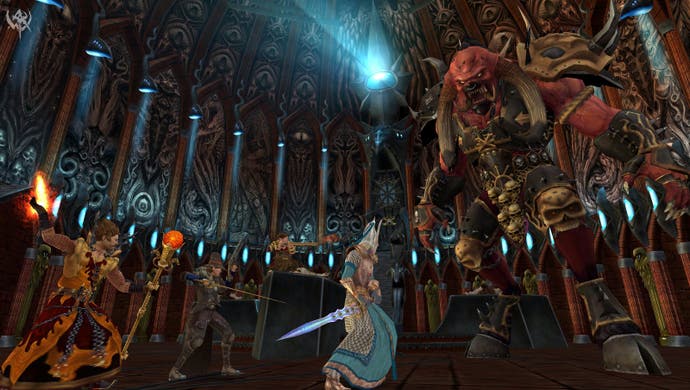
The broad, multi-faceted and flexible realm warfare system is rooted as deep in the game as it's possible to go, and has a dramatic manifestation in the capital cities. There is a lot that can go wrong with it: balancing realm populations, avoiding stalemates, pacing the conflict so it's not too frequent (city sieges should happen weekly at most, says Mythic) or too rare, giving victors enough time to enjoy their victory without frustrating the losers unduly.
However, Dark Age has granted Mythic experience in all of this. If it works, it ought to lend a strong sense of purpose and community focus - or, as Mythic puts it, "gang mentality" - to adventuring in WAR. Certainly, the game ought to avoid the "together alone" sense of whole worlds filled with self-motivated adventurers that besets other MMOs, WOW included.
Social organisation is reinforced in the game design at guild level, too. Guilds level up themselves - progressing through 80 ranks - and there's a heraldry system whereby they earn banners. These can be assigned tactical buffs that play an important part in skirmishing. They're hung proudly from keeps by the owners and can be taken from defeated guilds too, their tatters displayed as a trophy. The guild interface also looks like a vast improvement on the usual fare, including a facebook-style news feed.



